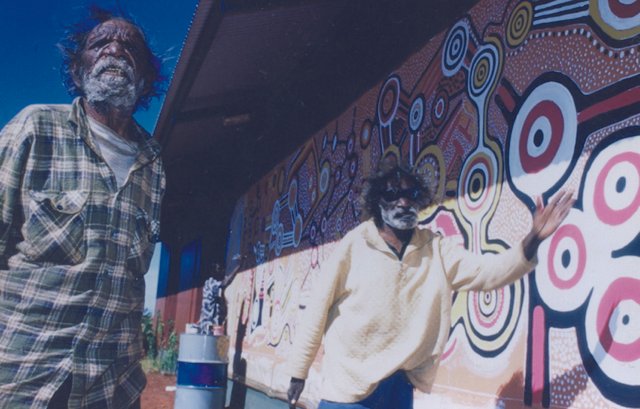TJUMPO TJAPANANGKA
MARKET ANALYSIS

Tjumpo Tjapanangka painted for almost twenty years but he was never considered one of Warlayirti’s major male artist’s until late in his life, by which time most of the older men could no longer paint or had passed away. His most productive and successful period was during his last five years when he and Helicopter Tjungurrayi had become the male mainstays of the art centre. While he painted very few large-scale works, and even paintings greater than 120 x 180 were rare, he did manage to complete one or two that measured up to 3 metres in length. These sold for as much as $40,000 in galleries when they were available between 2005 and the year he died.
Mirroring the prices for his works in the primary market, his prices at auction rose as his painting style developed. His record price was achieved for a subtly toned and beautifully executed work rendered in 2000 in his most contemporary style, Kukurpungku 2000, measured 180 x 119 cm. and sold for $40,450 at Sotheby’s in July 2005 (Lot 247) a price that was well over its estimate of $25,000-35,000.
In November 2007 Wati Kutjarra 2003, which had been sold through Tineriba Gallery in South Australia was offered for sale by Lawson-Menzies. (Lot 46). The work depicted the place where the ancestral brothers lit a large fire before Wilkinkarra (Lake MacKay), was formed. It was a wonderful example of the artists late career work with the red lines indicating the intensity of the flames and the yellow and white, the tali (sandhills), which dominate this country. The painting was estimated at $40,000-50,000, but despite its brilliant execution sold for just $34,800, still the artist’s 2nd highest price to date.
Another late career painting Untitled 2004 was close in style to this record work but nearly half the size. Painted for Papunya Tula Artists it failed to sell in Joel Fine Art’s June 2007 auction (Lot 49) even though its estimate was only $8,000-12,000. Funnily enough the only other work offered with Papunya Tula Provenance by this artist also failed to sell. When offered by Sotheby’s in November 2005, the work measuring just 91.5 x 60.5 and carrying a presale estimate of $1,500-2,500 was not illustrated in the auction catalogue that carried another two works by the artist including a 1994 rendition of his Kangaroo Dreaming. Both of these failed to raise interest from collectors yet when Kangaroo Dreaming 1994 originally estimated at $8,000 by Sotheby’s turned up at Lawson~Menzies in June the following year it did finally find a new home after being purchased for $6,000 (Lot 480).
Tjumpo’s paintings with Tingari designs or those painted in a multitude of colours tend to fare poorly at auction, particularly if the overall image is bright or lacking in subtle colour shifts that oscillate between his linear striations. Tastes may change, however brightly painted classic Balgo works are currently out of favour even by major artists like Tjumpo. His works fared poorly in 2007 with 4 of the 5 paintings offered remaining unsold and this resulted in a drop in his overall success rate from 64% to 59% where it remained at the end of the following year. In fact his clearance rate at the end of 2004 had been a very much more impressive 92%. However only 3 sold of 11 in 2004 and his results on the secondary market took a nosedive coinciding with his elevation as the most sought after male living artist at Balgo Hills and the art centre’s reliance on the sale of his works in the primary galleries.. This may change now that he has passed away and his works are no longer available on the primary market. Nevertheless 2007 saw a painting achieve his second highest result ever, and despite this being the only one of 5 paintings that sold during the year it was enough to see his average price rise from $7,154 to $8,609. It now sits at a very slightly lower $8,578.
I would not expect to see too many surprises with Tjumpo Tjapanangka’s early works at auction unless they represent the artist at his finest. The majority of his paintings will never be as important as those by Wimmitji, Sunfly Tjampitjin, Sam Tjampitjin and a number of others. However when fine examples of his late career works appear I would expect collectors to pay a premium, as they have a distinctive contemporary aesthetic and are on a par with anything created by the Papunya Pintupi male artist’s of the period.
© Adrian Newstead

